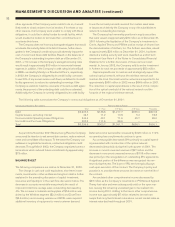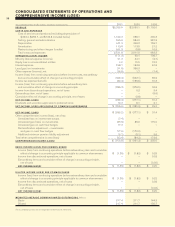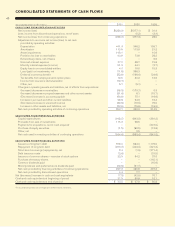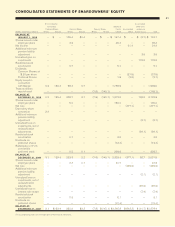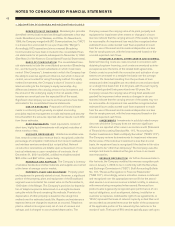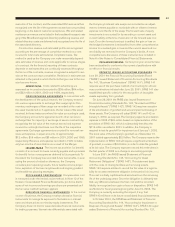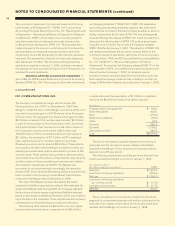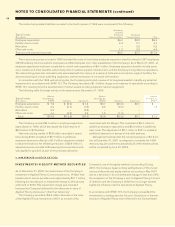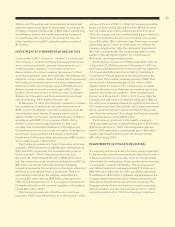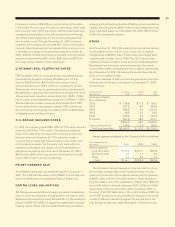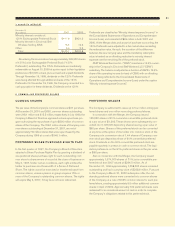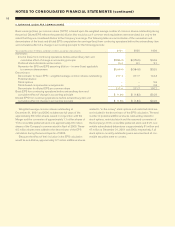Cincinnati Bell 2001 Annual Report Download - page 44
Download and view the complete annual report
Please find page 44 of the 2001 Cincinnati Bell annual report below. You can navigate through the pages in the report by either clicking on the pages listed below, or by using the keyword search tool below to find specific information within the annual report.
42
NOTES TO CONSOLIDATED FINANCIAL STATEMENTS
1. DESCRIPTION OF BUSI N E S S AND AC C OUNTING POLICIE S
DESCRIPTION OF BUSI N E S S Broadwing Inc. provides
diversified communications services through businesses in four seg-
ments: Broadband, Local, Wireless, and Other. On November 9,
1999, the Company merged with IXC Communications, Inc. (“IXC”)
in a transaction accounted for as a purchase (the “Merger”).
Accordingly, IXC’s operations (since renamed Broadwing
Communications) have been included in the consolidated finan-
cial statements for all periods subsequent to November 9, 1999
(See Note 2 of the Notes to Consolidated Financial Statements).
BASIS OF CONSOLI DATION The consolidated finan-
cial statements include the consolidated accounts of Broadwing
Inc., and its majority owned subsidiaries in which it exercises
control (“the Company”). Investments in which the Company has
the ability to exercise significant influence, but which it does not
control, are accounted for using the equity method. For equity
method investments, the Company’s share of income is calcu-
lated according to the Company’s equity ownership. Any
differences between the carrying amount of an investment and
the amount of the underlying equity in the net assets of the
investee are amortized over the expected life of the asset.
Significant intercompany accounts and transactions have been
eliminated in the consolidated financial statements.
USE OF ESTIMATESPreparation of financial state-
ments in conformity with generally accepted accounting
principles requires management to make estimates and assump-
tions that affect the amounts reported. Actual results could differ
from those estimates.
CASH EQUIVALENTS Cash equivalents consist of
short-term, highly liquid investments with original maturities of
three months or less.
U N B I LLE D RECEIVABL E S Unbilled receivables arise
from network construction revenue that is recognized under the
percentage-of-completion method and from local, broadband
and wireless services rendered but not yet billed. Network
construction receivables are billable upon achievement of con-
tractual milestones or upon completion of contracts. As of
December 31, 2001 and 2000, unbilled receivables totaled
$95 million and $67 million, respectively.
MATERIALS AND SU P P LI E S The Company’s inventory
of wireless handsets and other materials and supplies are carried
at the lower of average cost or market.
PROPERTY, PLANT AND EQUI P M E NT Property, plant
and equipment is generally stated at cost. However, a significant
portion of the property, plant and equipment of the Broadband
segment was recorded at fair market value on the November 9,
1999 date of the Merger. The Company’s provision for deprecia-
tion of telephone plant is determined on a straight-line basis
using the whole life and remaining life methods. Provision for
depreciation of other property is based on the straight-line
method over the estimated useful life. Repairs and maintenance
expense items are charged to expense as incurred. Telephone
plant is retired at its original cost, net of cost of removal and
salvage, and is charged to accumulated depreciation. The
Company reviews the carrying value of its plant, property and
equipment for impairment when events or changes in circum-
stances indicate that the carrying amount of the assets may not
be recoverable. An impairment loss would be recognized when
estimated future undiscounted cash flows expected to result
from the use of the asset and its eventual disposition are less
than its carrying amount, with the loss measured based on dis-
counted expected cash flows.
INTANGI B L E ASSETS, OTHER ASSETS AND GOODW I LL
Deferred financing costs are costs incurred in connection with
obtaining long-term financing; such costs are amortized as inter-
est expense over the terms of the related debt agreements.
Certain costs incurred with the connection and activation of cus-
tomers are amortized on a straight-line basis over the average
customer life. Goodwill resulting from the purchase of busi-
nesses and other intangibles are recorded at cost and amortized
on a straight-line basis from 2 to 40 years, with the vast majority
of recorded goodwill being amortized over 30 years. The
Company reviews the carrying value of long-lived assets and
goodwill for impairment when events or changes in circum-
stances indicate that the carrying amount of the assets may not
be recoverable. An impairment loss would be recognized when
estimated future undiscounted cash flows expected to result
from the use of the asset and its eventual disposition are less
than its carrying amount, with the loss measured based on dis-
counted expected cash flows.
INVESTMENTS Investments in publicly traded compa-
nies over which the Company does not exercise significant
influence are reported at fair value in accordance with Statement
of Financial Accounting Standard No. 115, “Accounting for
Certain Investments in Debt and Equity Securities” (“SFAS 115”).
The Company reviews its investments for impairment whenever
the fair value of the individual investment is less than its cost
basis. An impairment loss is recognized if the decline in fair value
is deemed to be “other than temporary.” The Company uses the
average cost basis to determine the gain or loss on an invest-
ment transaction.
REVEN U E RECO G N ITION As further discussed later in
this footnote, the Company modified its revenue recognition poli-
cies on January 1, 2000, to be in conformity with the Securities
and Exchange Commission’s (“SEC”) Staff Accounting Bulletin
No. 101, “Revenue Recognition in Financial Statements”
(“SAB 101”). Accordingly, service activation revenue is deferred
and recognized over the appropriate service life for the associ-
ated service. Local service revenue is billed monthly, in advance,
with revenue being recognized when earned. Revenue from
product sales is generally recognized upon performance of con-
tractual obligations, such as shipment, delivery, installation or
customer acceptance. Indefeasible right-of-use agreements, or
“IRUs,” represent the lease of network capacity or dark fiber and
are recorded as unearned revenue at the earlier of the acceptance
of the applicable portion of the network by the customer or the
receipt of cash. The buyer of IRU services typically pays cash upon


